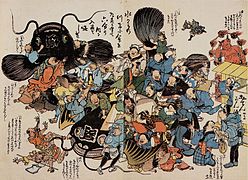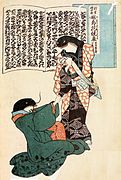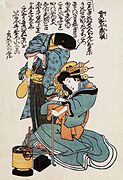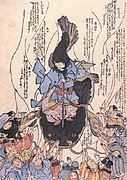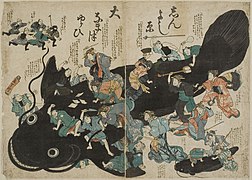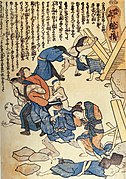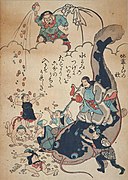Namazu-e
Namazu-e ( Japanese 鯰 絵 ) refers to a group of Japanese colored woodblock prints that were made following the severe earthquake in 1855. They show a mighty Namazu ( Ō-namazu ), i.e. a large catfish that was used to depict the cause of the earthquake.
Overview
The Ansei earthquake of 1855 caused great damage and resulted in many deaths. The humorous writer Kanagaki Robun ( 仮 名 垣 魯 文 ; 1829-1894) and the painter Kawanabe Kyōsai had the idea to publish a series of catfish pictures with reference to the earthquake, which became a brilliant idea and sheds light on it, like that Japanese people who are used to earthquakes and tsunami deal with such calamities. However, in order not to be held accountable by the government or society, these Namazu-e came into circulation without specifying the author.
In terms of content, several variants can be distinguished. The giant catfish hit by disgruntled local residents can be seen on a row of leaves. However, the catfish also appears in a personalized form, as a pharmacist, as a husband, as a kabuki actor. The beginning worship of the catfish at the Kashima Shrine is also an issue.
It is also typical that the pictures are accompanied by texts, and are often surrounded by sayings of those affected, who also see the catfish positively. The catfish in the Yoshiwara picture says: “I am very happy that courtesans are sitting on me. Happy! ”Or a guest says:“ Because of this catfish I lost six coins of 100 sen. For that I want to kill and eat him. ”The positive representation goes back to the fact that the large-scale destruction of the capital made a reconstruction necessary, which on the one hand brought a redistribution of wealth from rich (nobility) to poor (especially craftsmen) with it, on the other hand also new Freudenviertel became more affordable.
In terms of art history there is a connection with the Ōtsu-e , in particular the motif of the hyōtan namazu ( 瓢 箪 鯰 ' bottle gourd catfish' ) - illustrations in which a monkey or a person defeats a giant catfish with his bottle gourd. Iconographically, these in turn refer to Chinese depictions in which a deity or an immortal - sometimes equipped with a bottle gourd - rides a fish or dragon to prevent it from shaking the earth. The hyōtan-namazu pictures represent a metaphor for the fact that one can create seemingly impossible tasks through personal effort.
Prints
Remarks
- ↑ The residents in the north of Edo, who were spared by the earthquake, defend themselves against those affected by the center.
- ↑ A kabuki pair as two catfish. ( 村里 時 四郎 明烏 花 の 焼 衣 , Murazato Tokishirō Akegarasu Hana no yakeginu ).
- ↑ “On the second evening, another bitterness” ( 二 日夜 、 今 度 の 恨 , Futsuka yoru, kondo no urami ): The husband appears as a catfish with a sack of money in his hand.
- ↑ Worship of Namazu at the Kashima Shrine .
- ↑ The courtesans of Shin-Yoshiwara hit the catfish with sticks and a shamisen , supported by men hurrying up. At the bottom right, children with Kiseru are beating a small catfish.
Web links
literature
- Fukuda, Kazuhiko: Namazu ga nerikaetta. In: Nihon no sekimatsu. Yomiuri Shimbun, 1987. ISBN 4-643-87031-1 . S- 78 to 83.
- ↑ Namazu-e. In: Religion-in-Japan: A Web Handbook. University of Vienna. Bernhard Scheid, September 3, 2018, accessed on June 23, 2019 .
- ^ Gregory Smits: Conduits of Power: What the Origins of Japan's Earthquake Catfish Reveal about Religious Geography . In: Japan Review . No. 24 , 2012, p. 43-44, 47-48 , JSTOR : 41592687 .
- ^ Gregory Smits, Ruth Ludwin: Evolution of the Catfish (namazu) as an earthquake symbol in Japan. Seismological Society of America, 2016, accessed June 22, 2019 .

